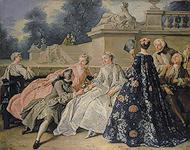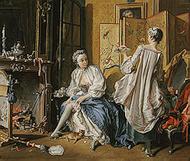Introduction |
Watteau and the Fête Galante |
Fashion and Gallantry |
Chardin
Greuze and His Followers |
Fragonard |
Boilly |
Image List |
Exhibition Information
Fashion and Gallantry
 To contemporaries, Jean-François
de Troy was best known as one of the greatest history painters of the first
half of the century--indeed, he ended his official career as director of the
French Academy in Rome. But he had also turned his hand to genre and in the
1720s and 1730s painted a series of brilliant scenes of dalliance and flirtation.
One of his masterpieces is The
Declaration of Love. It was acquired by the Prussian king Frederick II, a passionate collector of
contemporary French painting, and hung in his country palace of Sanssouci,
Potsdam, along with works by Watteau and Lancret. The Declaration of Love is derived from Watteau's fêtes galantes, showing as it does a group of seven young aristocrats dressed in the latest fashion, flirting in an elegant park. But the contemporary costumes depicted by De Troy with evident delight in their embroidery and brocade, their shimmer and sheen; the blatant gesture of the main protagonist as he presents a posy to the woman in a silver dress; and the exchanges of glance and gesture give the scene a more literal aspect than the ambiguous and melancholic poetry we encounter in the art of Watteau.
To contemporaries, Jean-François
de Troy was best known as one of the greatest history painters of the first
half of the century--indeed, he ended his official career as director of the
French Academy in Rome. But he had also turned his hand to genre and in the
1720s and 1730s painted a series of brilliant scenes of dalliance and flirtation.
One of his masterpieces is The
Declaration of Love. It was acquired by the Prussian king Frederick II, a passionate collector of
contemporary French painting, and hung in his country palace of Sanssouci,
Potsdam, along with works by Watteau and Lancret. The Declaration of Love is derived from Watteau's fêtes galantes, showing as it does a group of seven young aristocrats dressed in the latest fashion, flirting in an elegant park. But the contemporary costumes depicted by De Troy with evident delight in their embroidery and brocade, their shimmer and sheen; the blatant gesture of the main protagonist as he presents a posy to the woman in a silver dress; and the exchanges of glance and gesture give the scene a more literal aspect than the ambiguous and melancholic poetry we encounter in the art of Watteau.
 Sheer
delight in the material world--and the world of materials--is found in the
genre paintings of François Boucher. In midcareer he made several showing
young women absorbed in various daily activities, such as A
Lady Fastening Her Garter. These exquisite scenes celebrate the beauty of the women and
the lavish materiality
of their surroundings. His Presumed Portrait of Madame Boucher--"presumed" because
the model here employed is a generic type in Boucher's work and the title was
proposed only in the nineteenth century--shows a coquettish young woman, dressed
in the height of fashion, reclining on a daybed. After putting aside a book to
read a letter, she sits up reflectively amid a rich display of silk brocades,
a screen, and Chinese porcelain. Such scenes of opulent, privileged, and leisured
life, superbly rendered by Boucher with a jewel-like technique, found a ready
market both in France and abroad. But Boucher had trained as a history painter
and preferred to work on a more ambitious scale, making cartoons for tapestries
or decorations for palaces.
Sheer
delight in the material world--and the world of materials--is found in the
genre paintings of François Boucher. In midcareer he made several showing
young women absorbed in various daily activities, such as A
Lady Fastening Her Garter. These exquisite scenes celebrate the beauty of the women and
the lavish materiality
of their surroundings. His Presumed Portrait of Madame Boucher--"presumed" because
the model here employed is a generic type in Boucher's work and the title was
proposed only in the nineteenth century--shows a coquettish young woman, dressed
in the height of fashion, reclining on a daybed. After putting aside a book to
read a letter, she sits up reflectively amid a rich display of silk brocades,
a screen, and Chinese porcelain. Such scenes of opulent, privileged, and leisured
life, superbly rendered by Boucher with a jewel-like technique, found a ready
market both in France and abroad. But Boucher had trained as a history painter
and preferred to work on a more ambitious scale, making cartoons for tapestries
or decorations for palaces.
< previous: Watteau and the Fête Galante | next: Chardin >


